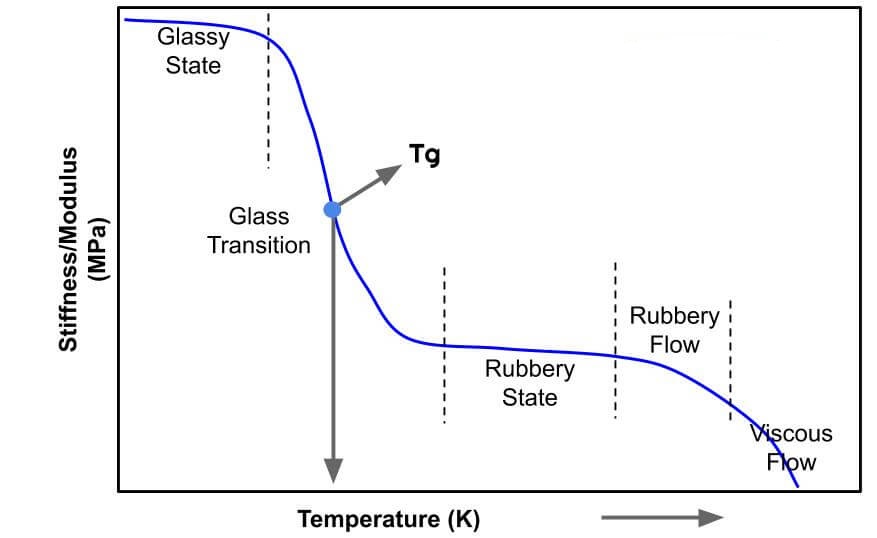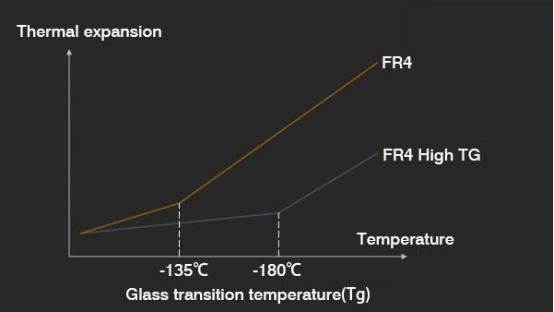
Tg, which stands for Glass transition temperature, is an abbreviation where "T" represents temperature and "g" is subscript, representing "Glass."
The Tg value, or glass transition temperature, refers to the temperature at which the PCB material transitions from a glassy state to a rubbery state. Below the Tg value, the material is in a glassy state, characterized by high rigidity and dimensional stability. Above the Tg value, the material enters a rubbery state, where the molecular chains begin to move, causing the material to soften and expand.

Glassy State: Refers to an amorphous solid state where the constituent atoms lack long-range order or translational symmetry in their structure. In layman's terms, it is a solid state that maintains characteristics similar to glass.
Rubbery State: Indicates that the chain segments are mobile, but the entire molecular chain does not move. In layman's terms, it is a solid state that deforms under force but can fully recover once the force is removed.
Viscous Flow State: Refers to the mechanical state under the influence of high temperature and significant external force over a long period. In layman's terms, it is a state where the material becomes a flowable liquid.
Tg is the starting temperature point at which polymeric materials transition from a glassy state to a rubbery state. The higher the Tg value, the stronger the material's ability to withstand thermal deformation.
The industry has long used the Tg value to classify the grades of FR-4 materials. It is generally believed that the higher the Tg value, the higher the reliability of the material.
The standard FR4 Tg is between 130–140°C, with a median Tg of 150°C, and a high Tg greater than 170°C. Generally speaking, consumer electronics motherboards typically use materials with a Tg of 135, while CPU motherboards, DDR memory substrates, and IC packaging substrates that require multiple high-temperature processes and operate in higher environmental temperatures use materials with a Tg of 180.

Determining the Tg value of PCB material requires consideration of the following factors:
The temperature range for lead-based soldering processes is 210–245°C, while lead-free soldering processes typically range from 220–260°C.
FR4 materials have a Td value, which is usually defined as the temperature at which 5% of the original mass is lost due to decomposition. When the material is heated to this temperature, the chemical bonds within the resin begin to break, and volatile components are released, resulting in a reduction of the resin within the PCB substrate.
Taking the materials from Kingboard as an example, the conventional FR4 material KB-6160 has a Tg of 135°C and a 5% mass loss Td of 305°C. The lead-free FR4 material KB-6168LE has a Tg of 185°C and a 5% mass loss Td of 359°C.
If conventional Tg135 material KB-6160 is used in a lead-free processing environment where the highest temperature reaches 260°C, although it does not reach the 5% mass loss Td of 305°C, it begins to lose 1.5–3% of its resin mass, which can directly affect the various electrical properties of the PCB. This may also lead to delamination and voiding phenomena during the soldering process.
When there are large-sized BGA packages on the PCB, it is generally preferable to select a high Tg FR-4 material. This is especially true when considering that the board may require SMT (Surface-Mounted Technology) secondary processing or multiple repairs.
In cases where the value of the chips is high, the thermal stability of high Tg materials can reduce the occurrence of cracks in the PCB traces and pad connections, as well as pad deformation, caused by temperature changes, thus improving the production yield of PCBA (Printed Circuit Board Assembly).
High Tg materials also offer higher reliability during PCB production and processing. When the hole pitch of the PCB is less than 12mil, using a high Tg material can effectively reduce the wicking effect during via processing, enhancing the production yield of the PCB.
If the circuit board will operate in a high-temperature environment, a material with a higher Tg value should be chosen to ensure its stability and reliability. For example, in automotive electronics, due to the high reliability requirements of electronic devices under different temperature environments, PCBs for automotive electronics typically require materials with a higher Tg value.
In summary, selecting a material with a higher Tg value will increase both the material cost and the processing cost. Therefore, a balance between performance and cost must be made when selecting the Tg value. The appropriate Tg value should be chosen based on the specific working environment and performance requirements of the product to achieve the best balance between performance and cost.
Note: The above content is collated from the Internet, and the copyright belongs to the original author. If there is any infringement, please contact us for deletion.